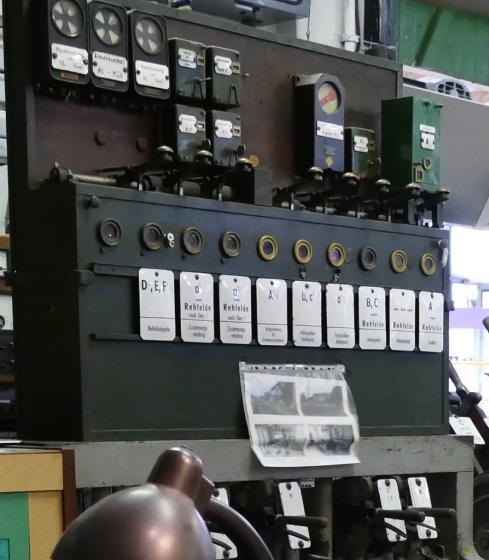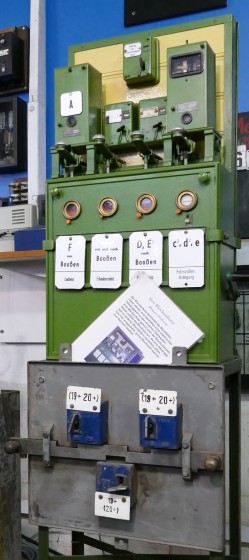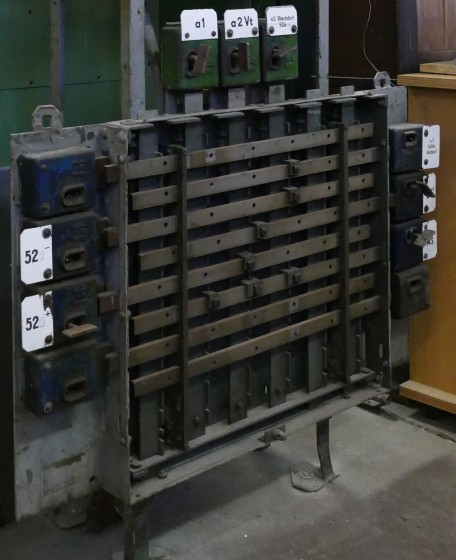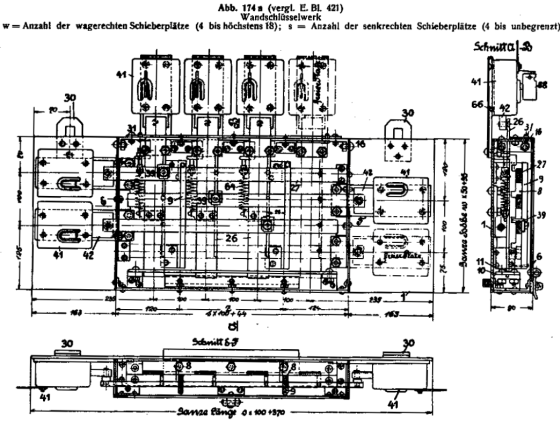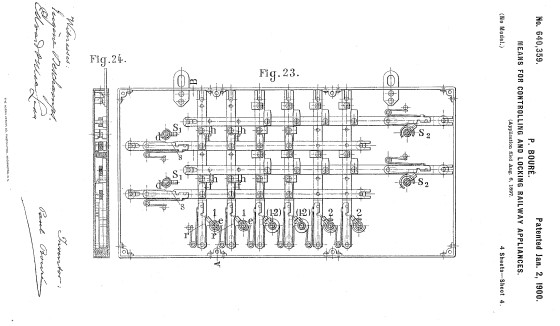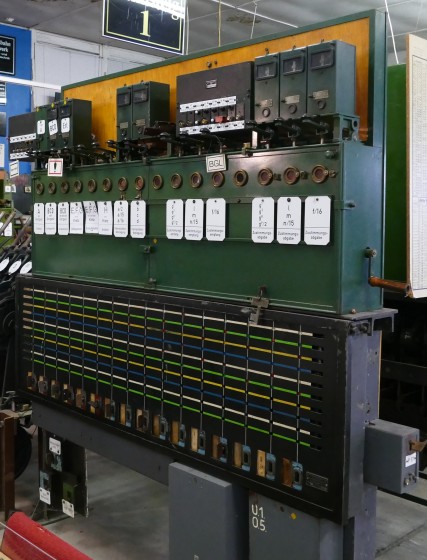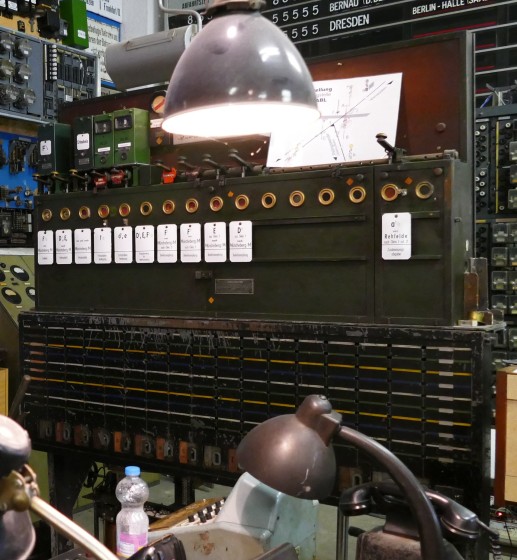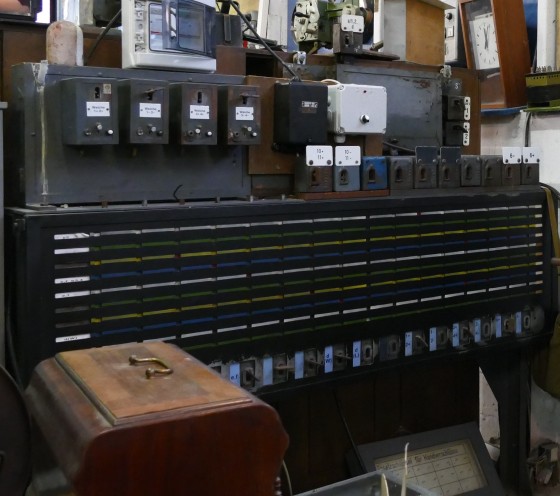After the generation of mechanical frames, electro-mechanical ones were introduced in Central Europe. Siemens & Halske (abbreviated S&H) installed the first one in 1894 at Prerov in Moravia (then, a part of the Habsburg monarchy), with another one in Germany at Berlin Westend in 1896. These were one-of-a-kind frames, but soon thereafter, Siemens developed a standard type called "1901" after the year of its introduction. The locking bed was taken from the mechanical Siemens type 3414 (which was very rarely installed in Germany, but was a standard type throughout many other European countries). This example of a 1901 frame stood at Berlin-Halensee:
S&H 1901 originally at Berlin-Halensee, railway museum Letschin, 2020
S&H 1901 originally at Berlin-Halensee, railway museum Letschin, 2020
The next type was designed from the ground up in 1907—here is one that survived at Eberswalde::
S&H 1907 originally at Eberswalde, railway museum Letschin, 2020
And here a small frame of standard type 1912 can also be seen—this type is obviously directly derived from type 1901. 1912s and minor variations that were developed over the following decades numbered in the thousands and were installed in many European countries:
S&H 1907 originally at Eberswalde, to the left there is an unknown S&H 1912, railway museum Letschin, 2020
S&H 1907 originally at Eberswalde, on the left an unknown S&H 1912, railway museum Letschin, 2020
The following picture shows a large 1912 frame from an unknown location:
S&H 1912, railway museum Letschin, 2020
Special Siemens & Halske frames were built for the Berlin underground. Similar frames were also used on Vienna's "Stadtbahn" (the precursor to the underground) in the 1920s, some of which I documented a few years ago—that posting has some additional explanations of this type (currently only in German). It is unclear whether this type was called "1915" officially:
S&H 1915 originally at Kottbusser Tor (Berlin underground), railway museum Letschin, 2020
S&H 1915 originally at Kottbusser Tor (Berlin underground), railway museum Letschin, 2020
During the times of the GDR, the Siemens type 1912 was modernized in many respects, which lead to type E12/78 (E for electro-mechanical, 12 for 1912, 78 for the year of the modernization):
E12/78 originally at Seelow (Mark), railway museum Letschin, 2020
In addition to the standardized E12/78, there were many additional improvements of 1912 type frames in Germany as well as in other countries. Here are a few examples from the Letschin museum:
Unknown modified interlocking frame derived from S&H 1912, railway museum Letschin, 2020
Unknown modified interlocking frame derived from S&H 1912, railway museum Letschin, 2020
Unknown modified interlocking frame derived from S&H 1912, railway museum Letschin, 2020
Larger stations with many points often had multi-row frames, typically with two or four rows (there was also a seven-row fame at Maastricht in the Netherlands). Here is a frame with two lever rows from Berlin-Grünau:
VES two-row lever frame originally at Berlin-Grünau, railway museum Letschin, 2020
VES two-row lever frame originally at Berlin-Grünau, railway museum Letschin, 2020
VES two-row lever frame originally at Berlin-Grünau, railway museum Letschin, 2020
Saxon railways for a time used a special "Saxonian station block", which allowed to set routes in large stations more efficiently than standard station blocking circuits. However, because of its technical complexity, it was not used anywhere else. Here is a command frame for such a Saxon station block from Dresden-Neustadt, built by Siemens. The frame looks similar to the upper part of a Siemens two-row lever frame which was used in Austria at signalbox 4 at shunting yard West in Linz:
Command frame of a Saxonian station block from Dresden-Neustadt, railway museum Letschin, 2020
Command frame of a Saxonian station block from Dresden-Neustadt, railway museum Letschin, 2020
Of course, there were other manufacturers of electro-mechanical frames besides Siemens. Here is a frame by AEG (an abbreviation for "Allgemeine Elektrizitäts-Gesellschaft", i.e. "general electric company"):
AEG electro-mechanical frame originally at Henningsdorf bei Berlin, railway museum Letschin, 2020
AEG electro-mechanical frame originally at Henningsdorf bei Berlin (in the background S&H 1901 originally at Berlin-Halensee), railway museum Letschin, 2020
Finally, here is a frame by Gaselan:
Unknown Gaselan two-row electro-mechanical frame, railway museum Letschin, 2020
Unknown Gaselan two-row electro-mechanical frame, railway museum Letschin, 2020
The same frame, but here a station block of type 51 stole into the picture:
Unknown Gaselan two-row electro-mechanical frame, railway museum Letschin, 2020
In the last picture, one can see another two row frame by Gaselan, which did its work at shunting signalbox Fgw at Frankfurt/Oder:
Gaselan-Zweireihenstellwerk originally at Frankfurt/Oder, railway museum Letschin, 2020
Gaselan-Zweireihenstellwerk originally at Frankfurt/Oder, railway museum Letschin, 2020
That's it, with electro-mechanical frames. The next and final posting will be about relay interlockings at Letschin.
